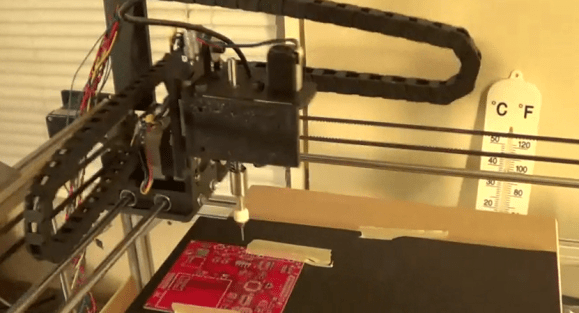
This sexy piece of CNC can really fly. It’s a pick and place machine which [Danh Trinh] has been working on. The thing is, so far it lacks the ability to move components at all. But the good news is the rest of the system seems to be there.
He posted a demo video of his progress so far which you can see embedded after the break. He starts of by showing off his computer vision software which he wrote in C#. The demonstration includes the view from the gantry-mounted camera, as well as the computer filtering which seems to accurately locate the solder pads and silk screen on the PCB. The second half of the video looks at the hardware seen above. It’s just executing some static code but the whine of those stepper motors is music to our ears. [Danh] reports that the movements of the needle that will eventually serve as the tip of the vacuum tweezer seem to be very accurate.
These home-built pick and place projects are quite a challenge, but we’ve seen a lot of really awesome work on them lately.
















you didn’t mention that this is the same guy that did the storage bot:
http://hackaday.com/2012/03/18/storagebot-finds-all-your-components-makes-your-storage-drawers-feel-inadequate/
For pick and place tasks a SCARA robot would be better.
Y’know, I’ve often thought the same thing. SCARAs find widespread use in other pick-and-place operations, but to my knowledge there aren’t any available for PCB assembly. It seems like doing away with gantry systems and their inherent futziness would be well worth the extra computational and encoder demands. Maybe it’s the irregular and inefficient work envelope?
There was one – Versatronics in the UK made a SCARA based pick/place in the 1990s. There are many still going, including mine. Very small fooprint & works pretty well but needs an occasional grid calibration to correct small position errors. The calculations of head rotations and fid camera to tool offsets must have been a major headf**k for the guy who did the software.
Here’s a video overview http://www.youtube.com/watch?v=ZaqvEftw7aI
..but of course any discusison of X/Y vs. SCARA or any other mechanics is irrelevant until someone solves the feeder problem properly. Without proper feeders any homebrew P&P is just a useless toy and a waste of time and space.
Why are feeders a “problem”? It seems like a pretty trivial thing to advance a punched tape a specific distance, I can think of plenty of ways and none seem especially complicated, a toothed wheel for each tape, or even have the placement head pull on the tape, like this one… http://hackaday.com/2011/02/24/magnetic-smd-pick-and-place/
Image processing to me however is like some sort of wizardry, I just wouldn’t even remotely know where to even begin thinking about it let alone doing it, that seems like such an unfathomably harder problem than just feeding a punched tape a known distance which is surely trivial in comparison.
I think the problems with feeders are cost, complexity, and size. You’re right, their fundamental function is to advance the tape, but they have to do that in a way that doesn’t jostle the parts from their pockets. In addition, they must remove the cover tape from the carrier tape, and do this as close and accurately as possible to the pick location, so as to prevent parts from dislodging during transport. This must all be done in a very confined space, since the P&P machine has a constrained work area; and it must be replicated as many times as necessary to support the number of distinct parts on the board, frequently in excess of 40-50. In professional assembly, it’s not uncommon to spend more on feeders than on the machine itself. That sounds counterintuitive until you consider machine changeover costs, both in labor and machine downtime. It’s much easier to slam in a new feeder or better yet feeder trolley than to restring individual feeders.
It seems to me using the head to advance the tape holds the most promise for a low cost system. That basically means you just need a nice precise slot for the tape to drop into. You certainly loose speed doing the tape advance with the head, but I’m not sure that it matters in the grand scheme of things. This comes at the tradeoff of more complex code driving the machine (but the advance routine would probably be implemented as a subroutine anyway).
Wow. I’m a bit embarrassed by the software. I just changed a dozen lines of code to add webcam cross hairs to an Emgu CV demo program. The G-code host program “Repetier” was already written for the 3d printer market. If you want to see decent software, search for OpenPNP. The guy that runs it is a JAVA wizard and he already wrote a fancy PNP interface. There’s also an active forum there.
There are tons of PNP machines out there with superior designs. However, my goal is to design a “good enough” machine to keep costs down.
You should have a look at using the Ultimaker ( http://Ultimaker.com ) as a pick and place platform. It’s very fast (see this video):
http://youtu.be/Om0wTqFA-Dw
Also, I’ve been working on a simple, integrated feeder that is in fact a parametric design. This means you can print it for any size of reel. So it’s really affordable to make a whole array for multiple components. My work on this is summarized here:
http://youtu.be/fsWpC6L91qo